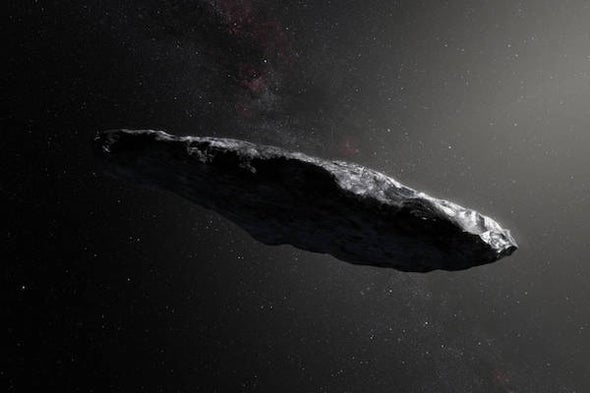|
|
Post by jandl100 on Nov 22, 2018 21:15:07 GMT
Do you remember that interstellar asteroid/comet thing from a few months back? - the unpronouncable Oumuamua. Obviously just a random rock thrown out by a nearby star. Well, here's a senior astronomer who is having serious doubts! Scientific American linkSo maybe not a  but a  |
|
|
|
Post by MartinT on Nov 22, 2018 21:42:44 GMT
I read that a few days ago and wondered!
Thanks for the link.
|
|
Deleted
Deleted Member
Posts: 0
|
Post by Deleted on Nov 23, 2018 9:35:47 GMT
Come on Jerry you live. Quite close to a interstellar travelling device it's buried under Shabb Hill they crashed landed a few millennia ago and have to wait until us backward race have discovered enough of the undiscovered elements so they can fix their craft I mean they have been breeding with the locals have you been Cinderford or Coleford recently obvious human DNA is not up to sustaining their great intellects or physical form  |
|
|
|
Post by jandl100 on Nov 23, 2018 13:34:33 GMT
He he - I know what you mean about some of the local-yokels here in deep Gloucestershire.    Back to the ooma-mooma thing - I've never seen any analysis of what the 'non-gravitatinal' manouevre actually achieved - was it a course correction, if so what effect will it have on where it goes? - if it lines it up better for its next encounter with another star then that would be intriguing indeed! |
|
|
|
Post by Slinger on Nov 23, 2018 13:40:59 GMT
Can we just resort to calling it Ummagumma, please?  |
|
|
|
Post by jandl100 on Nov 23, 2018 13:46:32 GMT
I believe that up north they are calling it ee-by-gumma.
|
|
|
|
Post by MartinT on Nov 23, 2018 14:56:04 GMT
I'm reminded of the excellent novel Pushing Ice by Alastair Reynolds, where Janus, one of Saturn's ice moons, inexplicably leaves its natural orbit and heads out of the solar system at high speed. What we've seen is subtle, but I'm sure we'll notice any further course correction made. Do we have the technology to go chasing it? Robotic, perhaps, but certainly not a human-capable transport on a one-way mission. |
|
|
|
Post by jandl100 on Nov 23, 2018 15:47:47 GMT
Do we have the technology to go chasing it? Robotic, perhaps, but certainly not a human-capable transport on a one-way mission. From that Scientific American article ... Oumuamua moves too fast for our chemical rockets to catch up with it now without a gravitational assist from planets. But since it would take ‘Oumuamua thousands of years to leave the solar system entirely, getting a closer look of it through a flyby remains a possibility if we were to develop new technologies for faster space travel within a decade or two. ============= The USS Enterprise would barely need to get into warpdrive. |
|
|
|
Post by MartinT on Nov 23, 2018 15:55:21 GMT
Assuming it doesn't detect that it's being chased and speeds up (a bit like on the M3 going home, sometimes).
|
|
|
|
Post by jandl100 on Nov 23, 2018 16:06:35 GMT
quite surprising that the Hubble space telescope didn't take a peek at it.
|
|
Deleted
Deleted Member
Posts: 0
|
Post by Deleted on Nov 23, 2018 16:18:32 GMT
Jerry,
You never know, maybe they did and discovered something that telling the rest of the world about may have caused mass hysteria, knowing humans flare form the dramatic.
Just a passing whim?
|
|
|
|
Post by jandl100 on Nov 23, 2018 16:57:25 GMT
ah, my mistake www.spacetelescope.org/news/heic1813/--- Oumuamua, the first interstellar object discovered in the Solar System, is moving away from the Sun faster than expected. This anomalous behaviour was detected using the NASA/ESA Hubble Space Telescope in cooperation with ground-based telescopes. I guess it was too small and far away to obtain an image of it |
|
|
|
Post by MartinT on Nov 23, 2018 17:21:32 GMT
It's not decelerating fast enough to allay suspicion that it's just a comet  |
|
|
|
Post by jandl100 on Nov 23, 2018 17:33:23 GMT
Well, according to that very senior astronomer chappy who wrote that SA article ....
The extra push for Oumuamua could have originated by cometary outgassing if at least a tenth of its mass evaporated. But such massive evaporation would have naturally led to the appearance of a cometary tail, and none was seen. The Spitzer telescope observations also place tight limits on any carbon-based molecules or dust around ‘Oumuamua and rule out the possibility that normal cometary outgassing is at play (unless it is composed of pure water). Moreover, cometary outgassing would have changed the rotation period of ‘Oumuamua, and no such change was observed.
|
|
|
|
Post by MartinT on Nov 23, 2018 17:46:13 GMT
Curiouser and curiouser...
|
|
|
|
Post by jandl100 on Nov 23, 2018 20:21:41 GMT
Just out of interest, here's a couple of gifs of the object's trajectory through our solar system   A random rock, or a fly-by observation and course correction for an alien interstellar probe?  |
|
|
|
Post by MartinT on Nov 23, 2018 20:59:52 GMT
After the closest encounter with Earth at 0.16au they must have seen enough and decided to return way in the future by which time we'll be all grown up or a cinder.
|
|